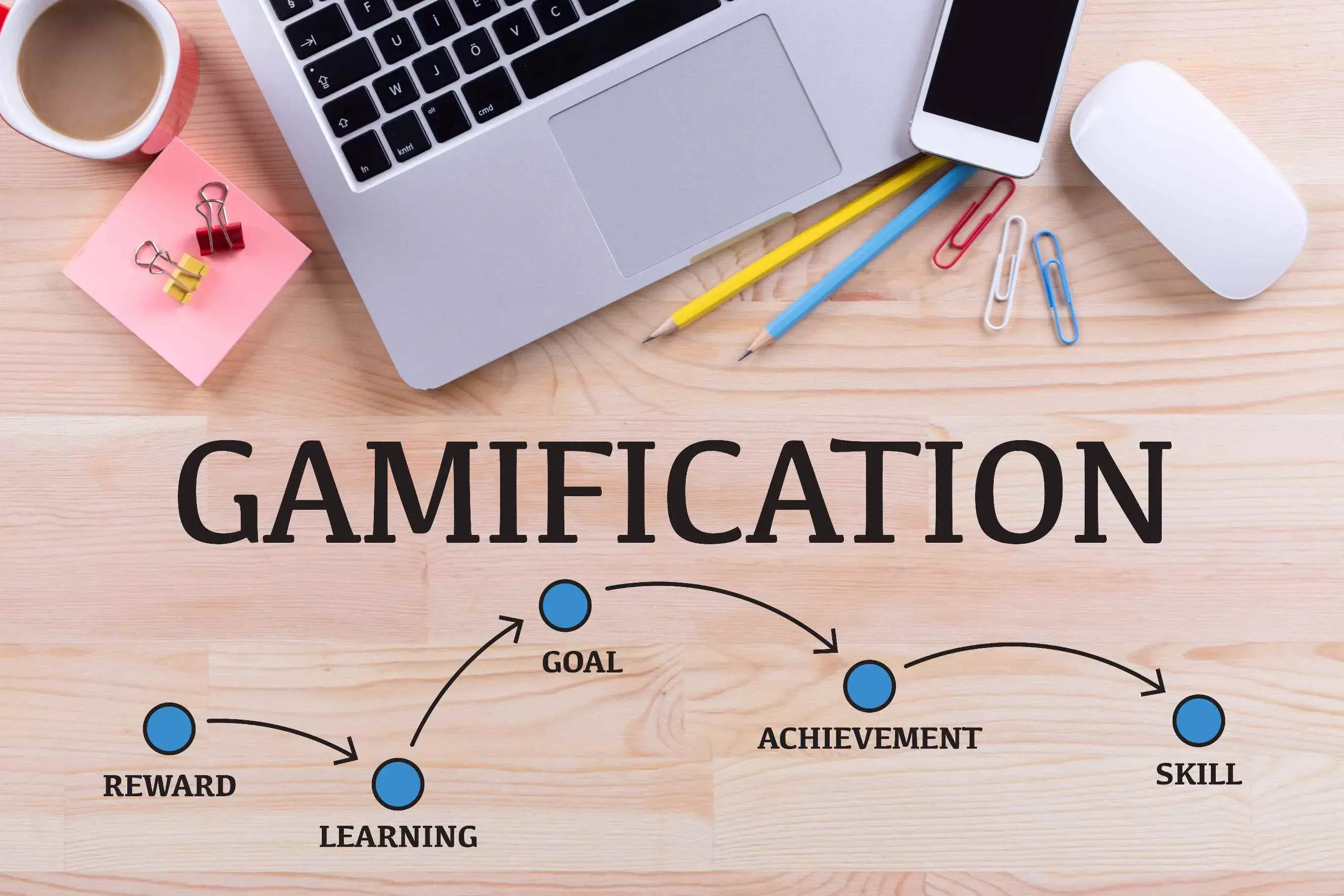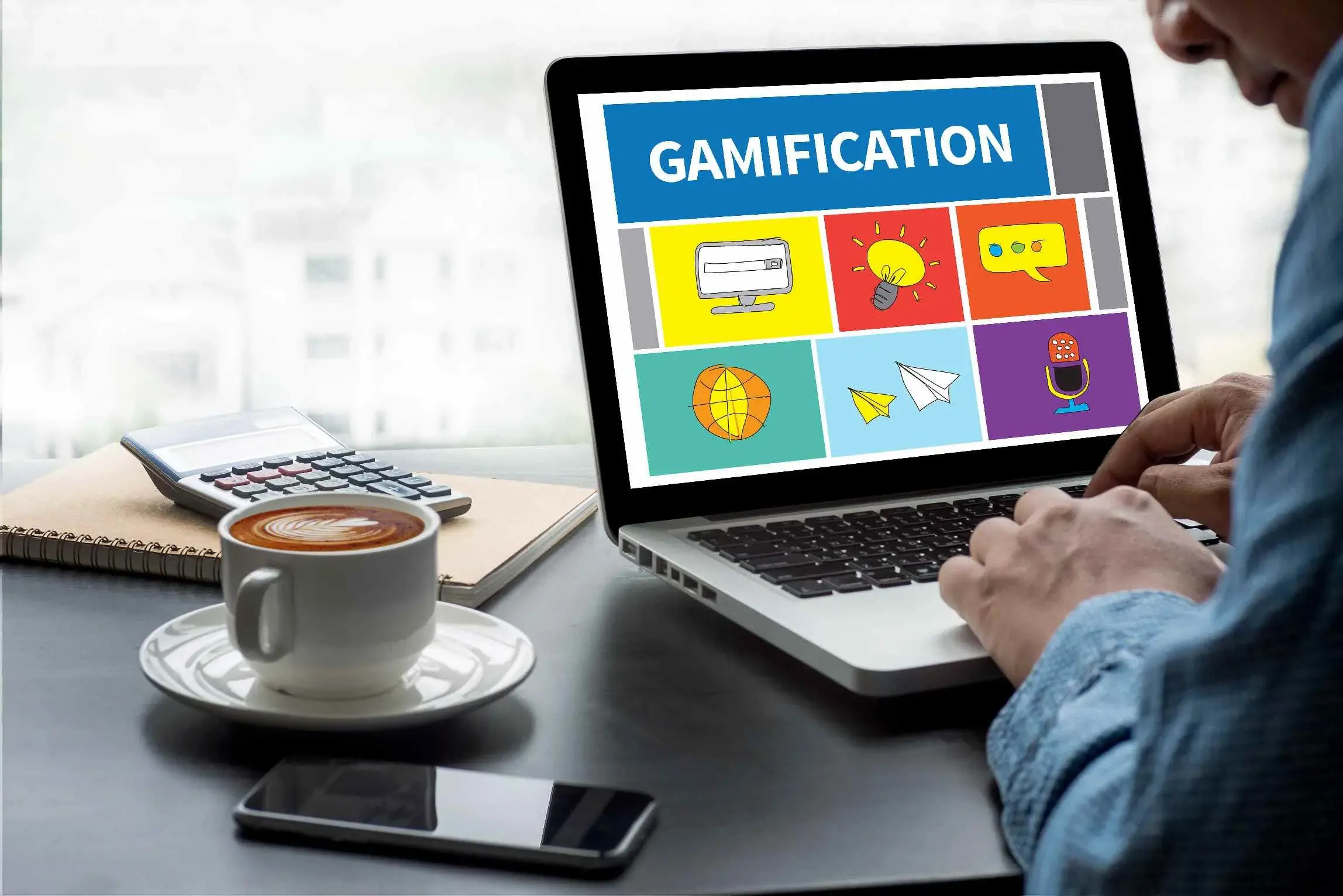In recent years, the integration of gamification into websites has become a popular strategy to enhance user engagement in the digital landscape. Leveraging game design principles to enhance user engagement, making interactions enjoyable, rewarding, and memorable.
This blog explores the world of website gamification, detailing how game-like elements such as points, badges, leaderboards, challenges, and rewards can turn ordinary online experiences into captivating journeys. By incorporating these elements, websites not only capture user attention but also instil a sense of motivation and accomplishment.
Website gamification aims to enhance user engagement, motivation, and interaction by integrating game-like elements and mechanics. Through the application of game design principles, gamification adds a layer of entertainment to non-game activities, making them more compelling for users.
Understanding Gamification
Gamification refers to the integration of game-like elements, mechanics, and principles into non-game contexts, such as websites, to enhance user engagement, motivation, and overall experience.
The primary purpose of gamification is to make mundane or routine activities more enjoyable and compelling by borrowing elements from games. It leverages psychological and behavioural motivators to drive user participation, loyalty, and desired actions.
Key Gamification Elements
- Points: Users earn points for completing specific tasks on a website. Points serve as a measurable and tangible representation of user accomplishments. Accumulated points can be redeemed for rewards or contribute to a user's overall status.
- Badges: Badges are virtual symbols awarded for achieving specific milestones or challenges. They visually represent accomplishments and serve as a source of pride for users. Badges can be displayed on user profiles to showcase expertise or dedication.
- Unlocks: Unlocks are rewards or features that become accessible as users progress through levels or complete tasks. They create a sense of anticipation and motivate users to explore and engage with the website to unlock new content or capabilities.
- Completion or Progress Bars: Visual indicators, such as progress bars, show users' advancement, offer a clear sense of direction, and encourage users to complete tasks to reach the next level or unlock additional benefits.
- Leaderboards: Leaderboards display user performance rankings of users, fostering competition and a sense of achievement. Users strive to improve their positions, driving continued engagement. Leaderboards create a social aspect by showcasing top performers and encouraging friendly rivalry.
Behavioural Economics in Gamification
Gamification often incorporates principles from behavioural economics to influence user behaviour. Behavioural economics combines insights from psychology and economics to understand how individuals make decisions.
- Scarcity: Limited-time offers or exclusive rewards create a sense of scarcity, motivating users to act quickly.
- Urgency: Time-sensitive challenges or events leverage the psychological principle of urgency, prompting users to engage promptly.
- Social Proof: Leaderboards and social features provide social proof of user achievements, influencing others to participate.
- Reward Systems: Gamification taps into reward systems to trigger the pleasure centres of the brain, reinforcing positive behaviours.
- Loyalty programs: Loyalty programs, often a part of gamification, rely on rewards to foster user retention and engagement.
The Benefits of Website Gamification

Increased User Engagement
Gamification transforms passive website visits into interactive experiences, motivating users to explore and participate in dynamic two-way engagements.
The introduction of game elements like challenges, points, and rewards incentivizes extended website interaction, reducing bounce rates and increasing overall session durations.
Enhanced Learning and Skill Development
Gamification, a powerful tool for education, transforms learning into a captivating experience with elements like quizzes, progress bars, and rewards.
Skill-based challenges and quests not only promote continuous user engagement but also foster skill development, motivating users to improve and acquire new skills as they progress through levels or achieve mastery in specific areas.
Improved User Retention
Gamified loyalty programs incentivize users to stay connected, offering rewards like discounts, exclusive content, or early access.
This gamification strategy creates an emotional connection, with achievements, badges, and personalised experiences fostering a sense of accomplishment and belonging for long-term relationships.
Strategies for Implementing Website Gamification
Understand Your Audience
Conduct in-depth user persona analysis to understand target audience demographics, preferences, and behaviour.
Tailor gamification elements to align with specific user segment interests and motivations. Continuously gather and analyze user feedback through surveys, polls, and feedback forms to refine and address pain points in the gamified experience.
Define Clear Objectives
Clearly define gamification objectives on your website, whether it is increasing user engagement, driving specific actions, or promoting brand loyalty.
Establish measurable KPIs, such as user retention rates and time spent, to evaluate the success of gamification efforts. Include metrics like completion of specific actions and conversion of users into premium members for a comprehensive assessment.
Choose Appropriate Game Mechanics.
Implement fundamental game mechanics like points, scores, and badges to reward user actions, assigning points for tasks, badges for achievements, and scores for overall performance.
Introduce leaderboards to foster competition among users and organize challenges with rewards for top performers, encouraging engagement and participation.
Seamless Integration with Website Design

When implementing gamification on a website, seamless user interface (UI) integration is crucial for creating a cohesive and enjoyable user experience.
User Experience (UX)
- Consistent Aesthetics: Gamification elements should blend seamlessly with the overall website design to maintain a cohesive and visually pleasing user interface.
- Intuitive Navigation: The integration should not hinder the website's navigation but rather enhance it, providing an intuitive and user-friendly experience.
Engagement and Motivation
- Visual Appeal: A well-integrated gamification design captures users' attention and encourages engagement by making the overall experience more visually appealing.
- Motivational Design: Gamification elements, when integrated seamlessly, can motivate users to explore the website, participate in challenges, and achieve goals.
Branding and Identity
- Consistent Branding: Seamless integration ensures that gamified elements align with the brand's identity, reinforcing the overall messaging and image.
- Positive Association: Users associate positive experiences with the brand when gamification is smoothly integrated into the website design.
Responsive Design Across Various Devices
- Accessibility: Ensure that gamified features are accessible across a variety of devices, including desktops, laptops, tablets, and smartphones.
- Consistent Functionality: Responsive design guarantees that gamification works uniformly on different screen sizes, maintaining functionality and user experience regardless of the device.
- Wider Reach: With the increasing use of mobile devices, a responsive design ensures that gamified elements reach a broader audience, maximizing engagement opportunities.
Examples of Website Gamification
1. Duolingo
Duolingo is a prime example of how gamification can make learning a new language more exciting. Users feel a sense of accomplishment as they move through levels and finish lessons.
Points for right answers, completed lessons, and virtual rewards like badges encourage steady learning. Challenges and duels with friends make it more fun and social.
Duolingo's success stories highlight how gamification makes learning enjoyable and helps people stay committed to learning a new language.
2. Nike Run Club
Nike Run Club gamifies fitness by turning running into a dynamic and social experience. The app uses game elements to motivate users to reach their running goals. You can set challenges, earn achievements for reaching milestones like specific distances or running a certain number of times, and see how you compare on leaderboards.
Sharing your runs and achievements with friends adds a social aspect to your fitness goals. Nike Run Club's strategy encourages users to share their achievements and connect with others, making fitness a shared and motivating experience.
3. LinkedIn
LinkedIn uses gamification to encourage users to fill out their profiles and showcase their work achievements. Completing profiles is made easy with prompts and visual progress indicators. When you finish, you get an "All-Star" profile status as a reward.
You can also endorse your connections' skills, making professional networking a bit like a game. These skill endorsements add strength and credibility to your profile.
LinkedIn's gamification helps show the importance of developing skills and getting recognized in professional networks. Users are motivated to improve their profiles and make a good impression online through skill endorsements.
Challenges and Future Trends in Website Gamification
User Fatigue: Users may experience fatigue or disinterest if gamification elements become repetitive or overwhelming. Regularly update and diversify gamification features to address this, ensuring alignment with user preferences. Monitoring user feedback helps identify potential issues and allows for timely adjustments.
Exclusivity and Alienation: Gamification strategies may unintentionally exclude certain user demographics, causing feelings of alienation. To address this, ensure gamification is inclusive and appeals to a diverse audience. Consider cultural sensitivities and avoid content that may isolate specific groups.
Lack of Personalization: One-size-fits-all gamification may not resonate with every user. To address this, implement personalization features that tailor the gamified experience to individual preferences and behaviour. Use data analytics to understand user preferences and adjust gamification elements accordingly.
Short-Term Engagement: Users might engage initially but lose interest over time. Continuously introduce new challenges, levels, and rewards to maintain long-term engagement. Encourage social interaction and friendly competition to sustain interest.
Accessibility Issues: Gamification features may not be accessible to users with disabilities. Ensure that gamified elements are designed with accessibility in mind, adhering to web accessibility standards. Provide alternatives or adjustments to accommodate users with different abilities.
Future Trends in Website Gamification
Combining Virtual and Augmented Reality: The integration of virtual and augmented reality enhances gamification, offering users a more immersive experience. Engaging with gamified content in a three-dimensional space provides a heightened sense of realism and interactivity.
Customizable Experiences: Personalizing gamification experiences based on individual preferences and behaviour, tailoring challenges, rewards, and overall gamified content to suit each user's unique tastes and motivations. This enhances engagement and satisfaction.
Conclusion
Website gamification is not merely a trend but a dynamic and evolving approach that significantly influences the digital landscape. It transforms ordinary online experiences into captivating journeys, fostering engagement, learning, and loyalty.
As we navigate the gamified terrain, it is essential to stay attuned to user preferences, leverage innovative technologies, and continuously evolve strategies to unlock the full potential of website gamification.
As users increasingly seek interactive and rewarding digital experiences, gamification stands as a beacon, guiding the way toward a more engaging and user-centric online world.
Ready to add some fun to your website? Try out gamification and see how it boosts engagement, learning, and loyalty. Stay curious and keep up with gamification trends to make your digital space even more awesome!
Frequently Asked Questions
Is gamification ethical?
Gamification itself is a neutral concept, but its ethicality depends on how it is implemented. Ethical gamification prioritizes user well-being, avoids manipulative practices, and ensures transparency. It's essential to consider the impact on users and maintain a balance between enjoyment and ethical considerations.
Is gamification costly?
The cost of implementing gamification can vary based on the complexity of the desired features. While some basic gamification elements can be implemented with reasonable investment, more advanced and customized gamification solutions may incur higher costs. The long-term benefits in terms of user engagement and loyalty often outweigh the initial investment.
Why do people love gamification?
People love gamification because it adds an element of fun, challenge, and reward to activities. It taps into the natural human inclination for competition and achievement, making experiences more enjoyable and motivating. Gamification provides a sense of progress and accomplishment, which resonates with users.
How do websites know what gamification to use?
Websites determine the appropriate gamification elements by understanding their target audience through user research and analysis. Knowing user preferences, behaviours, and motivations helps in selecting gamification features that align with the website's objectives and the expectations of the audience.
Is gamification for everyone?
While gamification can be appealing to a broad audience, it may not suit everyone's preferences. It is essential to consider the target demographic and tailor gamification elements to match their interests and motivations. Inclusivity and understanding diverse user needs are key factors in successful gamification.
Can gamification improve website loyalty?
Yes, gamification can contribute to improved website loyalty. By creating engaging and rewarding experiences, gamification encourages users to return to the website, participate in activities, and build a sense of loyalty. Loyalty programs, rewards, and achievements enhance the overall user experience and foster lasting connections.
How can gamification help in my online business?
In an online business, gamification can boost customer engagement, encourage repeat visits, and increase brand loyalty. It can reward customer actions, such as purchases or referrals, and create a more interactive and enjoyable shopping experience. Gamification strategies can enhance the overall customer journey and drive business growth.
Why does gamification fall short?
Gamification may fall short when not implemented thoughtfully. If gamification elements are irrelevant or poorly aligned with user preferences, they may not have the desired impact. Additionally, overemphasising gamification without addressing core issues in a product or service can lead to short-term engagement rather than lasting value. Successful gamification requires a deep understanding of users and a strategic approach.
Can gamification be applied to any type of website?
Yes, gamification can be applied to a wide range of websites across different industries. Whether it's an educational platform, fitness app, professional networking site, or e-commerce platform, gamification elements can be tailored to suit the specific goals and preferences of the target audience.
How can I measure the success of gamification on my website?
The success of gamification can be measured using key performance indicators (KPIs) such as user engagement metrics, user retention rates, time spent on the website, completion of specific actions, and conversion rates. Regularly analyzing these metrics provides insights into the effectiveness of gamification strategies.
Can gamification help with user onboarding?
Absolutely. Gamification can streamline user onboarding by providing interactive tutorials, guiding users through the platform's features, and rewarding them for completing essential steps. This makes the onboarding process more enjoyable and user-friendly.
What role does feedback play in gamification?
Feedback is crucial in gamification as it helps in refining and improving the user experience. Regularly collecting and analyzing user feedback allows website owners to understand what elements are working well and where adjustments are needed to enhance the overall gamified experience.
Can gamification be added to an existing website, or does it require a complete redesign?
Gamification can be added to an existing website without the need for a complete redesign. By strategically incorporating gamification elements and features, website owners can enhance the user experience and engagement without overhauling the entire site.
Can gamification be reversed if it doesn't yield the expected results?
Yes, gamification strategies can be adjusted or reversed if they don't yield the expected results. Regularly reviewing performance metrics and user feedback allows website owners to make informed decisions and modify gamification elements as needed to achieve the desired outcomes.
How does gamification impact SEO?
While gamification itself may not directly impact SEO, increased user engagement and longer time spent on the website can positively influence SEO rankings. Gamified elements that encourage users to explore

Yetunde Salami is a seasoned technical writer with expertise in the hosting industry. With 8 years of experience in the field, she has a deep understanding of complex technical concepts and the ability to communicate them clearly and concisely to a wide range of audiences. At Verpex Hosting, she is responsible for writing blog posts, knowledgebase articles, and other resources that help customers understand and use the company's products and services. When she is not writing, Yetunde is an avid reader of romance novels and enjoys fine dining.
View all posts by Yetunde Salami




















